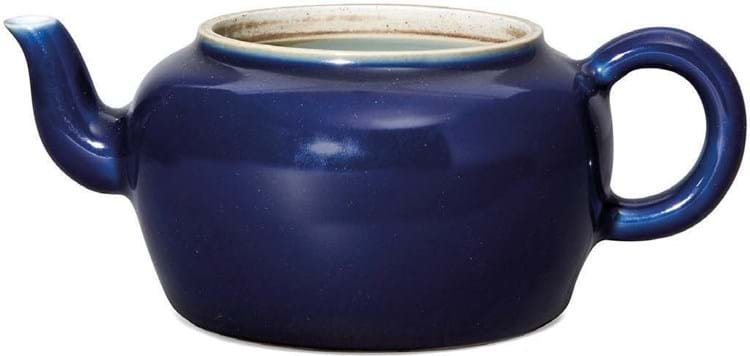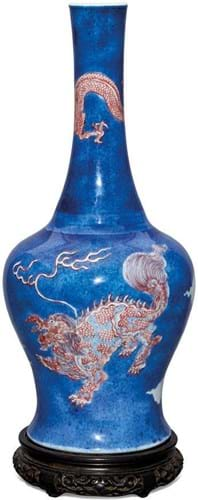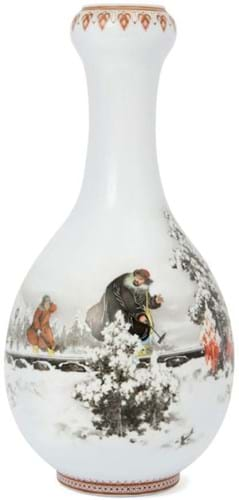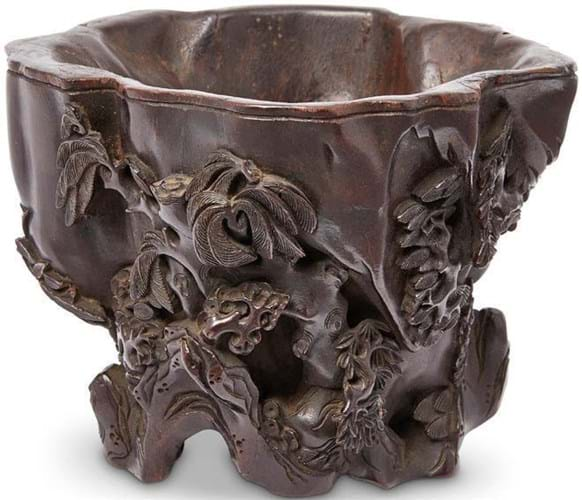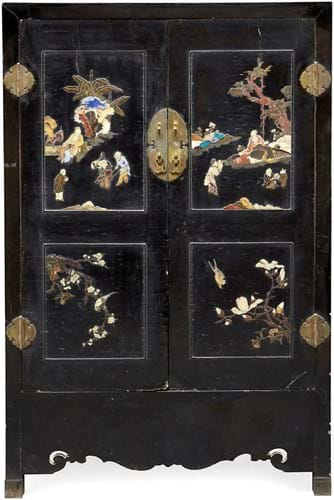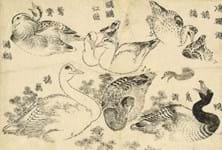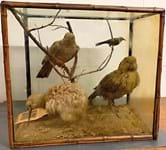“A seriously strong sale – our best by far.”
Specialist Bill Forrest was in upbeat mood following Roseberys’ (25% buyer’s premium) auction of Chinese, Japanese & South East Asian Art on July 28.
The 63-lot sale hammered £914,000 and included a pair of imperially inscribed Qianlong (1735-96) mark and period ruby famille rose wall vases sold for £260,000 – a house record for Asian art.
As reported in ATG No 2453, this 8in (20cm) pair had been unearthed in a private west London collection. They had been inherited by the vendor in c.1950 and had decorated the mantelpiece for half a century.
Chased by nine bidders in a 15-minute contest, they sold to an agent in the room relaying bids on behalf of a Chinese collector. The firm’s previous high in the category was £92,000 for a series of 14 Korean genre scenes by Kim Jun-Geum (Kisa) sold for £92,000 in May 2019.
Waiting game
Roseberys was among the auction houses which chose to mothball during the lockdown and wait until restrictions were lifted to begin selling again.
This sale, postponed from the spring, benefited from both maximum digital exposure (elements of the catalogue had been online since late March) and the chance to view in person.
“We were vindicated in our decision to postpone May’s sale until July,” said Forrest. “It allowed prospective buyers to attend our viewing days by appointment and handle objects in the flesh.”
It is something deemed essential in the Chinese market where fakes are an ever-present issue.

Jiaqing doucai ‘ducks and lotus’ marriage bowl – £30,000 at Roseberys.
Qing dynasty magnificence dominated the price list.
An early 19th century imperial doucai bowl was spotted in a kitchen cabinet five minutes from Roseberys. Delicately painted with mandarin ducks (symbolic of loyalty) swimming amid large lotus blooms (purity), the auspicious meaning of harmonious union were popular marriage gifts.
The rim has an underglaze blue dragon frieze to the exterior and a border of Tibetan lança script to the interior. Qing examples follow Ming examplars. Most were made in the Daoguang period (such as the similar piece sold for around £55,000 at Sotheby’s Hong Kong sale titled Marchant: 50 Qing Imperial Porcelains in 2020).
This 6½in (16.5cm) example (impeded by a rim that had been ground down t romove a small chip) was a little earlier and carried the reign mark for his predecessor Jiaqing (1796-1820).
The winning bid of £30,000 from a Chinese buyer in the room was at the lower estimate.
Heavenly productions
Monochrome cobalt-blue porcelains are associated with the Tiantan (the Temple of Heaven) where pieces of this type were used during the biannual imperial rituals.
The glaze is sometimes referred to in China as ‘sacrificial blue’. Here a 7in (17cm) teapot (pictured top) of squat shouldered form with simple loop handle carried a six-character mark Yongzheng (1722-35) reign mark within a double circle and was deemed of the period.
It lacked the cover that would have made this a six-figure object but was otherwise in good condition and few directly comparable pieces have been offered at auction recently. Estimated at £10,000-15,000, it took £42,000.
A powder blue ground Kangxi (1662-1722) period bottle vase, acquired by the vendor’s family prior to 1920, was notable for its large size and decoration in underglaze blue and copper red. It was part of a consignment that was valued and sent from Germany during lockdown.
Standing 16in (41cm) high, it was painted with a dragon to the neck and to the body with two chimeric beasts – perhaps a xiezhi, the mythical creature associated with justice endowed with the ability to pick out the guilty from the innocent. It had an apocryphal Ming mark to the base but dated from c.1700.
Despite a 2in (6cm) hairline crack to the rim, the winning bid of £19,000 from a Chinese phone bidder was well above the £5000-8000 guide. A similar vase, but smaller at 10in (25cm) and decorated only to the neck, had sold for £9000 at Roseberys’ sale in 2019.
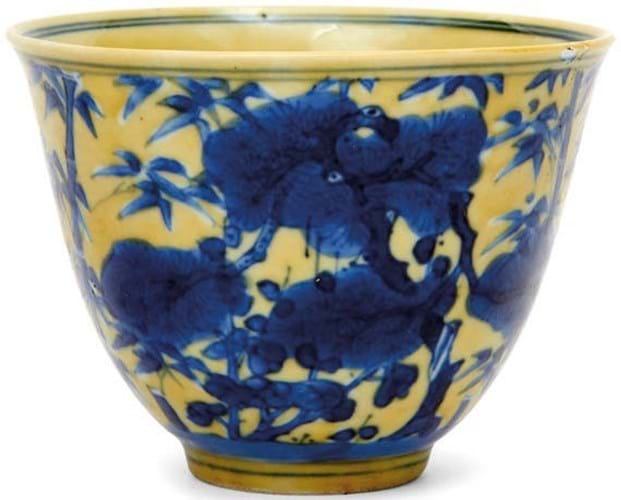
Jiajing ‘three friends of winter’ blue and yellow enamel wine cup – £12,000 at Roseberys.
Notable sums also came for wares made before and after the three centuries of Qing rule.
An online bid of £12,000 from the Chinese trade won a Jiajing (1527-67) underglaze blue and yellow enamel wine cup decorated with pine, prunus, and bamboo (the ‘three friends of winter’) that came from the collection of Jonas Gadelius and his wife Gabita.
Gadelius, a member of the well-known Swedish steel manufacturing family, grew up in Japan and later moved to London.
The cup had a small hairline crack.
People’s porcelain
Strong bidding for the best Republic period ‘qianjiang’ enamelled porcelain has become a familiar sight at Asian art sales. Less often observed is the newer enthusiasm for artist-decorated wares from the early years of the People’s Republic.
Underlining this evolving nature of the market, a 10in (25cm) Communist era garlic-head vase sold to a Chinese dealer in the room at £21,000 (estimate £3000-5000). The buyer paid his bill – unlike the high bidder for this piece at a previous sale.
Decorated in the famille rose palette with a propagandist scene of a father and son repairing a railroad in a winter landscape, it has an iron red seal to the base for the government-controlled Art Porcelain Factory in Jingdezhen and a paper label to the base for the Shropshire dealer Peter Wain.
It was Wain who pioneered British interest in 20th century Chinese ceramics through a series of exhibitions in the 1990s, making regular buying trips to China at time when major pieces were available and unloved.
Sworders sold a similar piece to this one – a dish decorated with a scene of girls dutifully repairing fishing nets – for £28,000 (plus 23% buyer’s premium) in November 2018. It was inscribed by the artist Tu Juqing and dated 1960, the time of the controversial economic and social campaign known as the Great Leap Forward.
Items made in aloeswood, the revered dark and resinous heartwood of the evergreen aquilaria tree known in China as chenxiangmu, are also demonstrating strong demand.
Forrest described a finely carved 4in (10cm) brush pot worked with bamboo and pine trees dated to c.1700 as “his favourite object in the sale”.
It emerged for sale from a private West Country collection, where it had been since at least the 1960s, to sell to an online bidder in China at £22,000 (£6000-8000).
Plenty of interest greeted a pair of much later Qing black lacquer and hardstone cabinets, pitched at a modest £300-500, that sold at a much punchier £18,000.
These were part of the full clearance of a Swiss castle conducted by Roseberys late last year. Dated to the early 20th century, these were inlaid to the doors with typical scenes of figures in landscapes.
Underbid in Hong Kong, they will be shipped to China.


